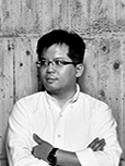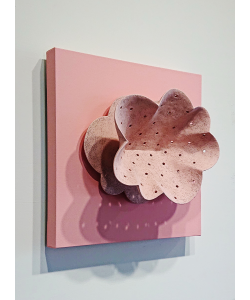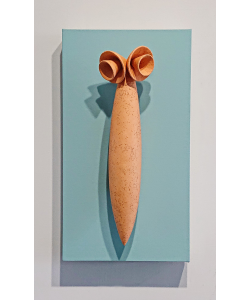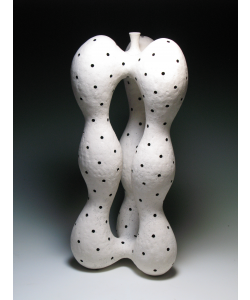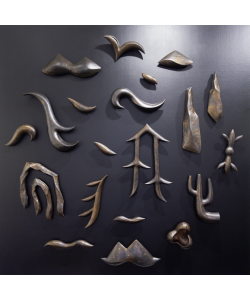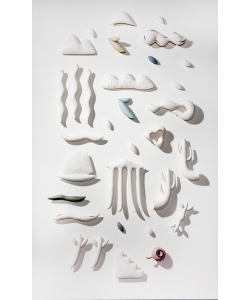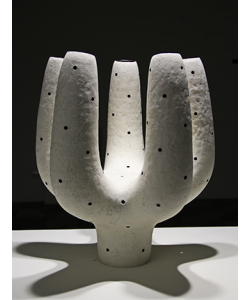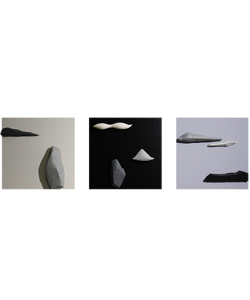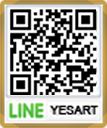Artists|藝術家
朱芳毅 / Chu,Fang Yi(1976~ )「物件」,是朱芳毅創造給自己的「自然」。對他來說,用身體感受泥土、親近泥土,是他認識自己、認識世界的重要過程。 |
|---|
朱芳毅現為專業當代藝術家,聯合國教科文組織國際陶藝學會會員(IAC),國立臺南藝術大學材質創作與設計系專任講師。
2008年獲得世界四大陶藝雙年展之一的臺灣國際陶藝雙年展首獎大獎,同年也獲選日本美濃國際陶藝三年展,
2011年更獲得韓國世界陶藝雙年展評審特別獎,在國內外公私立美術館展覽、獲獎、典藏無數。
創作上透過對自身生活、時代背景和文化認知的觀察,以物件雕塑的立體裝置形式關注深究於人的物件記憶與圖像、
物件真實與擬仿之間的圖像差異和人身體本能對圖像的閱讀想像…等相關議題。
Chu,Fang Yi is now a professional contemporary artist, a member of the UNESCO International Ceramic Society(IAC),and also a full-time lecturer in the Department of Material Arts and Design, TNNUA.
In 2008, he won the first prize of the Taiwan Ceramic Biennale, one of the world's four major ceramic biennales.In the same year, he was also selected as the International Ceramics Triennial Mino, Japan Executive Committee.
In 2011, he won the special award of the World Ceramics Biennale in Korea. He also exhibited in the public and private art museums at home and abroad, and won numerous awards and countless collections.
In creation, he focuses on the object memory and image of human beings in the form of stereoscopic device of object sculpture through the observation of his own life, historical background and the cultural cognition. And also the image difference between the real object and imitated object, and the human body instinct to read the images... and other related topics.
目前工作和居住於台灣台北、台南
個人網頁
www.chufangyi.url.tw
現職
國立台南藝術大學材質創作與設計系專任講師,台灣
聯合國教科文組織國際陶藝學會會員(IAC),瑞士
學歷
2005 國立台南藝術大學應用藝術研究所藝術創作碩士,台灣
1999 國立台灣藝術學院工藝系藝術學士,台灣
教學
2016 ~ 國立台南藝術大學材質創作與設計系專任講師,台灣
2015 ~ 2016 國立台南藝術大學材質創作與設計系兼任講師,台灣
2008 ~ 2010 國立台南藝術大學材質創作與設計系兼任講師,台灣
2006 ~ 2016 國立台灣藝術大學工藝設計系兼任講師,台灣
經歷
2014 駐村創作藝術家受邀於美國阿契布雷基金會,美國
2013 ~ 聯合國教科文組織國際陶藝學會會員(IAC),瑞士
2010 駐館創作藝術家受邀於比利時安田市陶瓷博物館、比利時
2009 駐村創作藝術家受邀於美國安德森牧場藝術中心,美國
2007 駐館創作藝術家受邀於台北縣立鶯歌陶瓷博物館,台灣
2006 文建會出國駐村創作視覺藝術家,台灣、美國
2005 駐村創作藝術家受邀於美國安德森牧場藝術中心,美國
2002 駐校創作藝術家受邀於美國密蘇里大學,美國
工作營示範講座
2019 陶藝工作營講座於韓國國際陶藝雙年展,韓國
2015 陶藝工作營講座於國立台灣工藝研究中心鶯歌分館,台灣
2015 陶藝工作營講座於新北市立鶯歌陶瓷博物館,台灣
2011 鹽燒工作營講座於國立台灣藝術大學,台灣
2010 陶藝工作營講座於比利時安田陶瓷博物館,比利時
2009 陶藝工作營講座於台北美國學校,台灣
2008 陶藝工作營講座於台北縣立鶯歌陶瓷博物館,台灣
2007 陶藝工作營講座於國立台灣工藝研究所,台灣
2002 陶藝工作營講座於美國印第安那州文森大學、密蘇里州密蘇里大學、西北密蘇里大學、歐札克學院、春田藝廊,美國
獎助
2015 獲國家文化藝術基金會美術類創作補助計畫,台灣
2011 獲文建會藝術及文化創意類國際展賽補助計畫,台灣
2010 獲國家文化藝術基金會美術類國際藝術交流補助計畫,台灣
2007 獲國家文化藝術基金會美術類創作補助計畫,台灣
2005 獲國家文化藝術基金會美術類國外進修補助計畫,台灣
獲獎
2019 第十屆韓國世界陶藝雙年展,現場決選入選,京畿道,韓國
2015 第九屆韓國清州國際工藝雙年展,入選,忠清北道,韓國
2013 高雄美術獎,入選,高雄,台灣
2012 南島國際美術獎,優選,台東,台灣
2011 第六屆韓國世界陶藝雙年展,特別獎,京畿道,韓國
2008 日本美濃國際陶藝三年展,入選,歧阜縣,日本
2008 臺灣國際陶藝雙年展,首獎,台北,台灣
2008 第一屆臺灣金壺獎陶藝設計競賽展,銅獎,台灣
2007 第四屆台灣陶瓷金質獎,單品設計,金獎,台灣
2007 台北美術獎,入選,台灣
2007 第五屆台北陶藝獎創作類,首獎,台灣
2007 第四屆韓國世界陶藝雙年展,入選,韓國
2006 台北縣美展雕塑綜合媒材類,首獎,台灣
2006 桃源創作獎,入選,台灣
2006 第三屆台灣陶瓷金質獎,套組設計,銀獎,台灣
2006 屏東美展應用藝術類陶藝,優選,台灣
2005 第四屆台北陶藝獎,入選,台灣
2005 南瀛藝術獎雕塑類,佳作,台灣
2005 全省美展雕塑類,優選,台灣
2003 玉山陶藝獎,首獎,台灣
2001 921重建精神陶瓷創作競賽,佳作,台灣
2000 第6屆台灣國際金陶獎,評審團特別獎,台灣
1999 南投縣陶藝獎,佳作,台灣
1999 第18屆澳洲黃金海岸陶藝競賽,優選,澳洲
1998 金鶯獎陶藝競賽,佳作,台灣
1998 南瀛美展陶藝類,佳作,台灣
個展
2021 「痕跡」,意識畫廊,台北,台灣
2019 「物象」,當代一畫廊,台北,台灣
2018 「非物之物」,巨年畫廊,香港,中國
2017 「身體閱讀」,真善美畫廊,台北,台灣
2015 「閱讀圖像」,新北市文化局藝文中心,新北市,台灣
2014 「物件閱讀」,國立台灣藝術大學,新北市,台灣
2012 「偽物-2012臺北國際藝術博覽會」,台北世貿中心,台北,台灣
2012 「偽物」,智邦藝術基金會,新竹,台灣
2010 「白色物件」,安田陶瓷博物館,安田市,比利時
2010 「存在記憶與夢境之間」,日升月鴻畫廊,台北,台灣
2008 「物件記憶.記號.記錄」,壢新藝術生活館,桃園,台灣
2005 「物件」,鶯歌陶瓷博物館,新北市,台灣
2005 「物件‧情境」,國立台南藝術大學,台南,台灣
2002 「朱芳毅個展」,春田陶瓷藝廊,密蘇里州,美國
重要聯展
2020 「變革之風—台灣當代陶瓷」聯展,巴爾第摩藝術中心,馬里蘭州,美國
2020 「這個問題就夠了」當代藝術展,日升月鴻畫廊,台北,台灣
2019 「擺花齊放- Flower art」創作展,伊通公園,台北,台灣
2019 第十屆韓國世界陶藝雙年展,利川陶瓷博物館,京畿道,韓國
2019 「Art Formosa藝術博覽會」,誠品行旅,台北,台灣
2019 「飲食物語—陶瓷器皿與文化的日常」,鶯歌陶瓷博物館,新北市,台灣
2018 「聯合國教科文組織國際陶藝學會(IAC) 會員展」,鶯歌陶瓷博物館,新北市,台灣
2017 「柏林當代藝術博覽會」,Postbahnhof郵政站,柏林,德國
2017 「2017亞洲當代藝術博覽會」,港麗酒店,香港,中國
2017 「好漢玩字藝術節」,駁二藝術特區,高雄,台灣
2017 「形塑無疆-臺灣當代陶藝進行式」,鶯歌陶瓷博物館,新北市,台灣
2016 「在路上,2016」中國青年藝術家作品提名展,關山月美術館,深圳,中國
2016 「翻轉實境」當代藝術創作展,黎畫廊,台北,台灣
2015 「漾藝術博覽會」,駁二藝術特區,高雄,台灣
2015 「粉樂町」台北東區當代藝術展,台灣大學,台北,台灣
2015 「擴增食境-當代藝術展」,駁二藝術特區,高雄,台灣
2014 「大器非凡」當代陶藝展,鶯歌陶瓷博物館,新北市,台灣
2014 「駐村藝術家聯展」,阿契布雷基金會,蒙大拿州,美國
2013 「後擴張時代的台灣當代雕塑-FORMOSA雕塑雙年展」,駁二藝術特區,高雄,台灣
2013 「記憶花園」-朱芳毅、游文富聯展,真善美畫廊,台北,台灣
2013 「標新‧立意-青年藝術家聯展」,國立台灣美術館,台中,台灣
2012 「2012南島國際美術獎」,台東美術館,台東,台灣
2011 「物²」-朱芳毅、戴翰泓聯展,一畫廊,台北,台灣
2011 第六屆韓國世界陶藝雙年展,利川陶瓷博物館,京畿道,韓國
2011 材質物語—「土」,朱銘美術館,台北,台灣
2010 「粉樂町」台北東區當代藝術展,台北101大樓,台北,台灣
2010 「嗑牙樂」臺灣國際陶藝雙年展,鶯歌陶瓷博物館,新北市,台灣
2010 「改造歷史-2000~2009的中國新藝術」,北京國家會議中心,北京,中國
2010 「三元素」-當代藝術三人展,一畫廊,台北,台灣
2009 「2009臺北國際藝術博覽會」,世貿中心,台北,台灣
2009 「演繹-『講‧述—2009海峽兩岸當代藝術展』」,國立台灣美術館,台中,台灣/中國美術館,北京,中國
2009 「當代價值:一個持續進行的歷史Part 2」-當代藝術展,日升月鴻畫廊,台北,台灣
2009 駐村藝術家聯展,安德森牧場藝術中心,科羅拉多州,美國
2009 「異質視界」-當代青年藝術聯展,MOT ARTS,台北,台灣
2009 「練金術」當代藝術展,百藝畫廊,台北,台灣
2008 「2008北京藝術沙龍」,中國國際貿易中心,北京,中國
2008 「2008臺北國際藝術博覽會-Made in Taiwan新人推薦特區」,世貿中心,台北,台灣
2008 日本美濃國際陶藝三年展,美濃陶瓷公園,歧阜縣,日本
2008 「台灣當代陶藝新銳展—空間‧像‧遊戲」,鶯歌陶瓷博物館,新北市,台灣
2008 「無垠」臺灣國際陶藝雙年展,鶯歌陶瓷博物館,新北市,台灣
2008 「粉樂町」台北東區當代藝術展,富邦金融大樓,台北,台灣
2008 「藝器.造藝─臺灣當代陶藝展」,中國美術館,北京,中國
2007 第四屆韓國世界陶藝雙年展,利川陶瓷博物館,京畿道,韓國
2007 陶藝香爐創作聯展,富貴陶園,台北,台灣
2007 「文建會出國駐村藝術家聯展」,VT藝文空間,台北,台灣
2007 「台北美術家大展」,鶯歌陶瓷博物館,台北,台灣
2006 「中華民國全國陶藝邀請展」,國立歷史博物館,台北,台灣
2005 駐村藝術家聯展,安德森牧場藝術中心,科羅拉多州,美國
2005 「大器六六」聯展,港區藝術中心,台中,台灣
2005 「大器六六」聯展,NCECA,巴爾第摩藝術中心,馬里蘭州,美國
2004 「茶壺」聯展,歐札克學院,密蘇里州,美國
2004 「大崎六六」聯展,交通大學藝文中心,新竹,台灣
2003 柴燒實用陶聯展,景陶坊藝廊,高雄,台灣
2002 當代陶藝展,中正藝廊,台北,台灣
2001 「第四章」雕塑聯展,巴爾第摩藝術中心,馬里蘭州,美國
2000 中華當代陶藝展,印地哥斯畫廊,丹佛市,科羅拉多州,美國
1999 「大崎六六」聯展,中央大學藝文中心,中壢,台灣
典藏
2016 [讀圖2015-1]、[讀圖2015-2],白兔美術館,雪梨,澳洲
2015 [飛越夢想],文化部藝術銀行,台中,台灣
2014 [偽物系列-遇見假象的真實],文化部藝術銀行,台中,台灣
2013 [幻景],文化部藝術銀行,台中,台灣
2013 [視覺‧記憶],香港旅遊發展局,香港,中國
2010 [白色物件],安田陶瓷博物館,安田市,比利時
2008 [無社會化的物件語言],國立台灣美術館,台中,台灣
2008 [物件記憶‧記號‧紀錄],鶯歌陶瓷博物館,台北,台灣
2007 [物件記憶‧記號‧紀錄-6],國立台灣美術館,台中,台灣
2007 [物件記憶與它的影子],鶯歌陶瓷博物館,台北,台灣
2007 [空間‧茶碗],鶯歌陶瓷博物館,台北,台灣
2006 [物件符號],國立台灣美術館,台中,台灣
2006 [鹽燒生活茶點組],鶯歌陶瓷博物館,台北,台灣
2003 [線性空間],南投縣文化局,南投,台灣
2002 [物件],聖蒂利亞當代藝術博物館,密蘇里州,美國
2002 [柴燒大壺],春田市藝術博物館,密蘇里州,美國
公共藝術
2013 [北投記憶],台北北投溫泉博物館,台灣
2009 [物件故事],台北捷運新莊線大橋國小站公共藝術,台灣
2008 台南縣烏山頭水庫橋樑藝術陶壁,台灣
2007 [地毯],台北縣立鶯歌陶瓷博物館陶瓷公園戶外大型雕塑,台灣
2006 [水波],台北縣立鶯歌陶瓷博物館陶藝工程,台灣
藝術合作
2016 「秘密花園」藝術商品計劃,台北晶華酒店,台北,台灣
2016 「八角哲學」藝術特展,華山文創園區,台北,台灣
2013 香港旅遊局「2013 香港。味道美食藝術展」,華山文創園區,台北,台灣
2012 米其林三星主廚江振誠藝術饗宴,台北晶華酒店,台北,台灣
2012 國立台灣美術館藝術典藏加值與應用—陶瓷文創商品開發品牌型塑計畫,台中,台灣
建築公共藝術創作案
2020 新北「三峽學勤」建案,永裕居建設,台灣
2019 新北「久泰皇品」建案,久泰建設,台灣
2019 台北「山翫水」建案,國美建設,台灣
2018 台中大毅老爺行旅,台灣
2017 高雄晶英國際行館藝術酒店,台灣
2017 台中「富邦天空樹」建案,富邦建設,台灣
2017 新北「久泰皇品」建案,久泰建設,台灣
2016 台北「中山隱」建案,欣偉傑建設,台灣
2015 新北「吉美君品」建案,吉美建設,台灣
2015 台北「吉美樸立」建案,吉美建設,台灣
2014 台北「信義頌」建案,寶明建設,台灣
2014 台北「台北信義」建案,太子建設,台灣
2013 台北「吉美悅河」建案,吉美建設,台灣
2013 台北「大安阿曼」建案,璞吉建設,台灣
2013 新北「一品花園」建案,吉美建設,台灣
2013 台北「忠順大院」建案,元利建設,台灣
2013 台北「千荷田」建案,吉美建設,台灣
2012 台北「中山富御」建案,怡富開發建設,台灣
2011 台北「貝森朵夫」建案,國美建設,台灣
2011 新北「橋峰」建案,大陸建設,台灣
2011 台中「海德一號」建案,精銳建設,台灣
2010 台中「大謙」建案,由鉅建設,台灣
2010 台北寒舍艾美藝術酒店,台灣
2010 台北「九昱十美」建案,忠泰建設,台灣
2009 高雄「都廳苑」建案,隆大建設,台灣
評審
2020 藝術銀行作品購藏計畫評選,台灣
2020 全國交趾陶工藝獎,台灣
2020 屏東伴手禮好物暨好店徵選活動評審,台灣
2019 新北市鶯歌陶瓷博物館常設展設計與製作評選,台灣
2019 新北市鶯歌陶瓷博物館申請展評選,台灣
2019 第四屆台灣青年陶藝雙年展,台灣
2019 全國美術展雕塑類,台灣
2017 第三屆台灣青年陶藝雙年展,台灣
2016 國際茶席之美美學設計大賽,台灣
2016 新北市鶯歌陶瓷博物館市民陶藝平台申請展,台灣
2014 新北市鶯歌陶瓷博物館-台灣陶藝駐村計畫,台灣
2013 法藍瓷國際陶瓷設計大賽,台灣
2012 苗栗陶藝獎,台灣
2012 法藍瓷國際陶瓷設計大賽,台灣
2011 新北市鶯歌陶瓷博物館-台灣陶藝駐村計畫,台灣
2011 苗栗陶藝獎,台灣
2011 法藍瓷國際陶瓷設計大賽,台灣
2010 比利時國際陶藝雙年展,安田市,比利時
2010 法藍瓷國際陶瓷設計大賽,台灣
專文發表
2019 「108年全國美展雕塑類評審專文」,【國立台灣美術館108年全國美展專刊/2019年6月】
2018 「可能之外」陶瓷創作實驗,【沂藝術網站/2018年9月】
2012 「2010比利時國際陶藝雙年展」【陶藝雜誌/2012年第74期】
2009 「風景如畫的安德森牧場藝術中心駐村介紹」【陶博館季刊/2010年春季刊】
學術演講
2019 韓國祥明大學陶瓷設計系,首爾,韓國
2018 日本岡山縣立大學設計學院,岡山,日本
2018 香港浸會大學視覺藝術學院,香港,中國
專題演講
2018 「雕刻藝術與生活美學-中國雕刻藝術博覽會」,雕藝博物館,惠安,中國
2018 「兩岸青瓷文化研討會」,越青堂文化中心,紹興,中國
2017 「形塑無疆-臺灣當代陶藝進行式」講座,鶯歌陶瓷博物館,新北市,台灣
2014 「阿契布雷基金會」駐村講座,蒙大拿州,美國
2010 「2010臺灣國際陶藝雙年展」論壇,鶯歌陶瓷博物館,新北市,台灣
2010 「2010比利時國際陶藝雙年展」講座,安田陶瓷博物館,安田市,比利時
2009 「安德森牧場藝術中心」駐村講座,科羅拉多州,美國
策展
2018 「可能之外」陶瓷創作實驗展,沂藝術,台北,台灣
CHU, Fang-Yi
Now live and work in Taipei、Tainan, TaiwanWEBSITE
www.chufangyi.url.twPOSITION
Instructor, Department ofMaterial Arts & Design, Tainan National University of the Arts, Tainan, TaiwanMember of UNESCO International Academy of Ceramics (IAC)
EDUCATION
2005 Institute of Applied Arts, Tainan National University of the Arts (MFA), Tainan, Taiwan1999 Department of Industrial Arts, Taiwan College of the Arts (BFA), Taipei, Taiwan
TEACHING EXPERIENCE
2015~2016 InstructorDepartment ofMaterial Arts & Design, Tainan National University of the Arts, Tainan, Taiwan2008~2010 Instructor, Department ofMaterial Arts & Design, Tainan National University of the Arts, Tainan, Taiwan
2006~2016 Instructor, Department of Crafts & Design, National Taiwan University of Arts, Taipei, Taiwan
EXPERIENCE
2014 Artist in Residence, Archie BrayFoundation, Montana, U.S.A2013~ Member of UNESCO International Academy of Ceramics (IAC)
2010 Artist in Residence, Andenne Ceramics Museum, Andenne, Belgium
2009 Artist in Residence, Anderson Ranch Arts Center, Colorado, U.S.A
2007 Artist in Residence, Yingge Ceramics Museum, Taipei, Taiwan
2006 Artist in Residence(Council For Cultural AffairGrant), Colorado and New York, U.S.A
2005 Artist in Residence, Anderson Ranch Arts Center, Colorado, U.S.A
2002 Artist in Residence, Missouri State University, Springfield, Missouri, U.S.A
WORKSHOP
2019 Workshop and Lecturer,Korean International Ceramic Biennale 2019, Korea2015 Workshop and Lecturer,National Taiwan Craft Research Institute, Yingge, Taiwan
2015 Workshop and Lecturer, Yingge Ceramics Museum, Taipei, Taiwan
2011 Soda Workshop, in the National Taiwan University of Arts. Taipei, Taiwan
2010 Workshop and Lecturer, Andenne Ceramics Museum, Andenne, Belgium
2009 Workshop, in the Taipei American School. Taipei, Taiwan
2008 Workshop and Lecturer, Yingge Ceramics Museum, Taipei, Taiwan
2007 Workshop and Lecturer, National Taiwan Craft Research Institute, Nantou, Taiwan
2002 Workshop and Lecturer, in the Vincennes University, Indiana, Missouri State University,
Northwest Missouri State University, College of the Ozarks, Missouri, U.S.A
GRANTS
2015 National Culture and Arts Foundation Grant. Taiwan2011 Council for Cultural AffairGrant, Taiwan
2010 National Culture and Arts Foundation Grant. Taiwan
2007 National Culture and Arts Foundation Grant. Taiwan
2005 National Culture and Arts Foundation Grant, Taiwan
HONOR AND AWARDS
2019 Final Selected on-site of the 10th World Ceramic Biennale Korea International Competition, Korea2015 SELECTED of the 9th Cheongju International CraftCompetition, Chungcheongbuk-do, Korea
2013 SELECTEDof KaohsiungContemporary Art Award, Kaohsiung, Taiwan
2012 MERIT PRIZE of Austronesia International Arts Award 2012, Taiwan
2011 SPECIAL AWARD of the 6th World Ceramic Biennale Korea International Competition, Korea
2008 SELECTED of the 8th International Ceramics Competition, Gifu, Japan
2008 GRAND PRIZEof Taiwan Ceramics Biennale 2008, Taiwan
2008 BRONZE PRIZE of Taiwan Teapot Art Award, Taiwan
2007 GOLD PRIZE of Taiwan Functional Pottery Art Award, Taiwan
2007 SELECTED of Taipei Contemporary Art Award, Taipei, Taiwan
2007 GRAND PRIZEof the 5th Taipei Ceramics Award, Taipei, Taiwan
2007 SELECTED of the 4th World Ceramic Biennale Korea International Competition, Korea
2006 FIRST PLACE AWARD of Sculpture of Taipei Fine Art exhibition, Taipei, Taiwan
2006 SELECTED of Taoyuan Contemporary Art Award, Taoyuan, Taiwan
2006 SILVER PRIZEof the Taiwan FunctionalPotteryArt Award, Taiwan
2006 MERIT PRIZE of the Pingtung Fine Art exhibition, Pingtung, Taiwan
2005 MERIT PRIZE of the Tainan Ceramics Art Award, Tainan, Taiwan
2005 MERIT PRIZE of the Taiwan Ceramics Art Award, Taiwan
2003 FIRST PLACE AWARD of the Yu-shan National Ceramic Art Award, Nantou, Taiwan
2000 JUDGE'S SPECIAL AWARD of the Taiwan International Golden Ceramics Awards, Taiwan
2000 FINAL SELECTION of the 8th Taiwan Competition of Industrial Arts Design, Taiwan.
2000 MERIT PRIZE of the First Nantou Ceramics Art Award, Taiwan
1999 MERIT PRIZE of the 18th Gold Coast International Ceramic Art Award, Australia
1998 MERIT PRIZE of the Cold Yin Ceramics Art Award, Taipei, Taiwan
1998 MERIT PRIZE of the Tainan Ceramics Art Award, Tainan, Taiwan
SOLO EXHIBITIONS
2021 「Traces」,YESART Gallery, Taipei, Taiwan2019 「Pictographic Objects」,Contemporary One Gallery, Taipei, Taiwan
2018 「Object of Non-object」,Giant Year Gallery, Hong Kong, China
2017 「Instinctive Reading」,Kalos Gallery, Taipei, Taiwan
2015 「Reading Image」, Cultural Affairs Department, Taipei, Taiwan
2014 「Object of Reading」, National Taiwan University of the Arts, Taipei, Taiwan
2012 「Pseudo-object-ART TAIPEI 2012」, Taipei World Trade Center, Taipei, Taiwan
2012 「Pseudo-object」,Accton Arts Foundation, Hsinchu, Taiwan
2010 「White Objects」, Andenne Ceramics Museum, Andenne, Belgium
2010 「The Existence between Memory and Dream」,Ever Harvest Art Gallery, Taipei, Taiwan
2008 「Objects Memory, Sign, Record」, Li-Shin Hospital, Taoyuan, Taiwan
2005 「Objects」, Yingge Ceramics Museum, Taipei, Taiwan
2005 「Objects in Space」, Tainan National University of the Arts, Tainan, Taiwan
2003 「Chu, Fang-Yi」Solo Exhibition, Springfield Pottery, Springfield, Missouri, U.S.A.
GROUP EXHIBITIONS
2020 「The Wind of Change—The Contemporary Ceramics of Taiwan」, Baltimore, Maryland, U.S.A.2020 「This question is enough」Contemporary Art,Ever Harvest Art Gallery, Taipei, Taiwan
2019 「Flower art」Contemporary Art, ITPARK, Taipei, Taiwan
2019 「The 10th World Ceramic Biennale Korea International Competition」, Icheon Ceramics Museum,
Gyeonggi-do, Korea
2019 「ART FORMOSA 2019」Art Fair, Eslite hotel,Taipei, Taiwan
2019 「A Tale of Food and Tableware-Ceramics and Culture in Daily Lives」, Yingge Ceramics Museum, Taipei, Taiwan
2018 「International Academy of Ceramics Members Exhibition」, Yingge Ceramics Museum, Taipei, Taiwan
2017 「2017 BERLINER LISTE Fair for Contemporary Art」, Postbahnhof, Berlin, Germany
2017 「2017 Asia Contemporary Art」, Conrad Hotel, Hong Kong, China
2017 「The Delight of Chinese Character Festival 2017」, The Pier-2 Art Center, Kaohsiung, Taiwan
2017 「Infinite Forms」, A Cross-Field exhibition, Yingge Ceramics Museum, Taipei, Taiwan
2016 「On the Road-2016」Nomination Exhibition of Chinese Young Artists, Guan Shanyue Art Museum,Shenzhen, China
2016 「Reverse Reality」, the Contemporary Arts Exhibition, Lee Gallery, Taipei, Taiwan
2015 「2015 Kaohsiung Young Art Fair」, The Pier-2 Art Center, Kaohsiung, Taiwan
2015 「VERY FUN PARK」, the Contemporary Arts Exhibition, Taipei, Taiwan
2015 「Augmented food」, the Contemporary Arts Exhibition, The Pier-2 Art Center, Kaohsiung, Taiwan
2014 「Great Talents, Great Scope」, A Cross-Field exhibition, Yingge Ceramics Museum, Taipei, Taiwan
2014 「Associated Exhibition of Artist in Residence」, Archie BrayFoundation, Montana, U.S.A
2013 「Contemporary Sculpture of Taiwan in Post-Expansion Era, FORMOSA Sculpture Biennial 2013」,The Pier-2 Art Center, Kaohsiung, Taiwan
2013 「Memory Garden」,Chu, Fang-Yi and Yu, Wen-FuExhibition, Kalos Gallery, Taipei, Taiwan
2013 「Innovation & Re-creation:Selected Works from the NTMoFA Young Artist Collection」,
National Taiwan Museum of Fine Arts, Taichung, Taiwan
2012 「Austronesia International Arts Award 2012」, Taitung ArtMuseum,Taipei, Taiwan
2011 「Objects 2」,Chu, Fang-Yi and Tai, Han-Hong Exhibition, A Gallery, Taipei, Taiwan
2011 「The 6th World Ceramic Biennale Korea International Competition」, Icheon Ceramics Museum, Gyeonggi-do, Korea
2011 「Material Language—Soil」,JUMINGMuseum, Taipei, Taiwan
2010 「VERY FUN PARK」,the Contemporary Arts Exhibition, Taipei, Taiwan
2010 「KORERO-Taiwan Ceramics Biennale 2010」,Yingge Ceramics Museum, Taipei, Taiwan
2010 「Reshaping History-China art from 2000~2009」, China National Convention Center, Beijing, China
2010 「The three elements」Exhibition, A Gallery, Taipei, Taiwan
2009 「ART TAIPEI 2009」Exhibition, Taipei World Trade Center, Taipei, Taiwan
2009 「The two sides across the Taiwan Strait Contemporary Arts Exhibition」,National Taiwan.
Museum of Fine Arts, Taichung, Taiwan / National Art Museum of China, Beijing, China
2009 「Contemporary Value—A Processing HistoryPart 2」,Ever Harvest Art Gallery, Taipei, Taiwan
2009 「Associated Exhibition of Artist in Residence」, Anderson Ranch Arts Center, Colorado, U.S.A.
2009 「Contemporary Young Artists Group Exhibition」,MOT ARTS, Taipei, Taiwan
2009 「REFINES GOLD—Contemporary Arts Exhibition」,100Gallery, Taipei, Taiwan
2008 「BEIJING ART SALON」, China World Trade Center, Beijing, China
2008 「ART TAIPEI 2008-Made in Taiwan:Young Artist Discovery」,Exhibition, Taipei World Trade Center, Taipei, Taiwan
2008 「The 8h International Ceramics Competition of Mino」, Mino Ceramic Park, Gifu, Japan
2008 「Contemporary Ceramics in Taiwan—SPACE‧IMAGE‧GAME」, Yingge Ceramics Museum, Taipei, Taiwan
2008 「BOUNDLESS-Taiwan Ceramics Biennale 2008」,Yingge Ceramics Museum, Taipei, Taiwan
2008 「VERY FUN PARK」,the Contemporary Art, Taipei, Taiwan
2008 「Contemporary Ceramics in Taiwan」, National Art Museum of China, Beijing, China
2007 「The 4th World Ceramic Biennale Korea International Competition」, Icheon Ceramics Museum, Gyeonggi-do, Korea
2007 Associated Exhibitionof the Ceramics Censer, FuguiCeramic Gallery, Taipei, Taiwan
2007 Associated Exhibition of Artist in Residence(Council For Cultural AffairGrant),VT Art Gallery, Taipei, Taiwan
2007 Associated Exhibition of Taipei Artist, Yingge Ceramics Museum, Taipei, Taiwan
2006 Associated Exhibition of the National Ceramics, National Museum of History, Taipei, Taiwan
2005 Associated Exhibition of Artist in Residence, Anderson Ranch Arts Center, Colorado, U.S.A.
2005 Associated Exhibition inFuhwa Culture and Art Foundation, Taipei, Taiwan
2005 Associated Exhibition in Since Well Art Gallery, Kaohsiung, Taiwan
2005 Associated Exhibition in Taichung county Seaport Art Center, Taichung, Taiwan
2005 Associated Exhibition in NCECA, Baltimore, Maryland, U.S.A.
2004 Associated Exhibition in the Art Center of Chiao Tung University, Hsinchu,Taiwan.
2003 Associated Exhibition in Ching-tao-fang Ceramic Gallery, Kaoshung, Taiwan
2002 Associated Exhibition of the Contemporary Ceramics, Chung-Cheng Art Gallery, Taipei, Taiwan
2001 Associated Exhibition in Baltimore Clayworks, Baltimore, Maryland, U.S.A.
2000 Associated Exhibition of the Chinese Contemporary Ceramic Art Exhibition, Denver, U.S.A
1999 Associated Exhibition in the Art Center of Central University, Taoyuan, Taiwan
COLLECTIONS
2016 White Rabbit Art Museum, Sydney, Australia2015 Art Bank,Ministry of Culture, Taichung, Taiwan
2014 Art Bank,Ministry of Culture, Taichung, Taiwan
2013 Art Bank,Ministry of Culture, Taichung, Taiwan
2013 Hong kong Tourism Board, Hong kong, China
2010 Andenne Ceramics Museum, Andenne, Belgium
2008 National Taiwan Museum of Fine Arts, Taichung, Taiwan
2008 Yingge Ceramics Museum, Taipei, Taiwan
2007 National Taiwan Museum of Fine Arts, Taichung, Taiwan
2007 Yingge Ceramics Museum, Taipei, Taiwan
2007 Yingge Ceramics Museum, Taipei, Taiwan
2006 National Taiwan Museum of Fine Arts, Taichung, Taiwan
2006 Yingge Ceramics Museum, Taipei, Taiwan
2003 Nantou County Government Cultural Bureau, Taiwan
2002 Daum Museum of Contemporary Art, Sedalia, Missouri, U. S. A.
2002 Springfield art museum, Springfield, Missouri, U.S.A.
PUBLIC ARTS
2013 Beitou Hot Spring Museum,Taipei, Taiwan2009 Daqiao Elementary School of Department of Rapid Transit System, TCG,Taipei, Taiwan
2008 Outdoor Large Ceramicart projects of Tainan County government, Taipei, Taiwan.
2007 Outdoor Large-Scale Ceramic Sculpture, Yingge Ceramics Museum, Taipei, Taiwan.
2005 Ceramicart projects of the Yingge Ceramics Museum, Taipei, Taiwan
ART and ARCHITECTURE COOPERATION
2020 「Sanxia-Xueqin」, New Taipei City, Taiwan2019 「Jiu Tai Huang Pin」, New Taipei City, Taiwan
2019 「Shan Wan Shui」,Taipei, Taiwan
2018 「The Place」hotel, Royal Hotel Group, Taichung, Taiwan
2017 「Silks Club」hotel, Kaohsiung, Taiwan
2017 「Fubon Sky Tree」, Taichung, Taiwan
2017 「Jiu Tai Huang Pin」, New Taipei City, Taiwan
2016 「Zhong Shan Yin」,Taipei, Taiwan
2015 「Ji Mei Jun Pin」, New Taipei City, Taiwan
2015 「Ji Mei Pu Li」,Taipei, Taiwan
2014 「Xinyi Song」,Taipei, Taiwan
2014 「Taipei Xinyi」,Taipei, Taiwan
2013 「Ji Mei Yue He」,Taipei, Taiwan
2013 「Da An A Man」,Taipei, Taiwan
2013 「Yi Pin Hua Yuan」,Taipei, Taiwan
2013 「Zhong Shun Da Yuan」,Taipei, Taiwan
2013 「Qian He Tian」,Taipei, Taiwan
2012 「Zhong Shan Fu Yu」,Taipei, Taiwan
2011 「Bosendorfer」,Taipei, Taiwan
2011 「QiaoFeng」, New Taipei City, Taiwan
2011 「HYDE Park One」, Taichung, Taiwan
2010 「Da Qian」, Taichung, Taiwan
2010 Taipei Le Meridien hotel, Taiwan
2010 「Jiu Yu Shi Mei」,Taipei, Taiwan
2009 「Du Ting Yuan」, Kaohsiung, Taiwan
JURY
2020 Selection of Art Bank Collection Project, Taiwan2020 National Koji-Pottery Craft Award, Taiwan
2020 Selection of Pingtung Goods and Good Stores, Taiwan
2019 Yingge Ceramics Museum-Permanent exhibition, Taiwan
2019 Yingge Ceramics Museum-Application Exhibition, Taiwan
2019 Taiwan Young Pottery Artist Award &Biennale, Taiwan
2019 National Art Exhibition, Taiwan
2017 Taiwan Young Pottery Artist Award &Biennale, Taiwan
2016 The International Tea Table-Aesthetics Design Competition, Taiwan
2016 Yingge Ceramics Museum-Application Exhibition, Taiwan
2014 Yingge Ceramics Museum-Artist in Residence, Taiwan
2013 FRANZ AWARD 2013, Taiwan
2012 Miaoli Ceramic Award 2012, Taiwan
2012 FRANZ AWARD 2012, Taiwan
2011 Yingge Ceramics Museum-Artist in Residence, Taiwan
2011 Miaoli Ceramic Award 2011, Taiwan
2011 FRANZ AWARD 2011, Taiwan
2010 Belgium Ceramics Biennale 2010, Belgium
2010 FRANZ AWARD 2010, Taiwan
ARTICLE REVIEW
2019 「2019 National Art Exhibition, ROC」【National Taiwan Museum of Fine Arts/2019 June.】2018 「Outside of Possible」: Ceramic Experimental Creation Exhibition【YIART Website/2018 Sep.】
2012 「Belgium Ceramics Biennale 2010」【Ceramic magazine/2012 Issue 74】
2009 「Introduction Anderson Ranch Art Center」【Yingge Ceramics Museummagazine/2010 Spring】
ACADEMIC LECTURE
2019 SeoulSangmyung University, Seoul, Korea2018 Okayama Prefectural University, Okayama, Japan
2018 Hong Kong Baptist University, Hong Kong, China
TOPIC LECTURE
2019 「The 10th Korean International Ceramic Biennale」, Icheon Ceramics Museum, Gyeonggi-do, Korea2018 「Carving Art and Life Aesthetics - China Carving Art Fair」Seminar, Carving Art Museum, Huian,
China
2018 「Chinese Celadon Culture Seminar」,Yue-Qing Tang Cultural Center, Shaoxing, China
2017 「Infinite Forms-The Contemporary Ceramics in Taiwan」Lecture, Yingge Ceramics Museum, New
Taipei, Taiwan
2014 「Archie BrayFoundation」Resident Lecture, Montana, U.S.A
2010 「Taiwan Ceramics Biennale 2010」Seminar, Yingge Ceramics Museum, New Taipei, Taiwan
2010 「Belgium Ceramics Biennale 2010」Lecture, Andenne Ceramics Museum, Andenne, Belgium
2009 「Anderson Ranch Art Center」Resident Lecture, Colorado, U.S.A
CURATION
2018 「Outside of Possible」Ceramic Experimental Creation Exhibition,YIART, Taipei, Taiwan非花之花之一 Flower of non-flower I朱芳毅 Chu,Fang Yi40x40x18cm |
| SOLD |
|---|
非花之花之二 Flower of non-flower II朱芳毅 Chu,Fang Yi25x45x12cm |
| NTD 50,000 |
|---|
靈魂與視覺的錯置 Misplaced soul and vision朱芳毅 Chu,Fang Yi30x60x30cm |
| Price on Request |
|---|
讀圖貳零壹玖之壹 Image reading 2019-1朱芳毅 Chu,Fang Yi165x165cm |
| Price on Request |
|---|
讀圖 貳零壹伍之壹 Image reading 2015-1朱芳毅 Chu,Fang Yi150x250x20cm |
| Price on Request |
|---|
非物之物之壹 Object of Non-object-1朱芳毅 Chu,Fang Yi45x55x45cm |
| SOLD |
|---|
物象之肆 Pictographic Objects-4朱芳毅 Chu,Fang Yi170x50x15cm |
| NTD 240,000 |
|---|
文/ 莊秀玲(藝術評論)
站在朱芳毅《文字景》物件山水作品面前,彷彿自己就是莊子《逍遙遊》篇中那展翅高飛的大鵬鳥,徜徉在這片無垠的大山大水之間。
以「物件」尋找真正的「感覺」
朱芳毅是約在2006-07年間,對故宮館藏的甲骨文、銘文產生了濃厚興趣。這些有自然物象相對應但被簡化的圖像符號,讓他回想起高中時期對設計的熱情,更開啟2007年之後「物件記憶」系列作品的創作,並在作品獲得2008年臺灣國際陶藝雙年展首獎之後,確立了自己的創作理路與方向。
他的「物件記憶」系列,以生活物品為造形的基本元素,或簡化或複雜化其原來的外形,讓「物件」有了相像、類似但又少許怪異的造形。他是有意識地以無目的、無意識的手法,拆解、拼湊完成新的「物件」,有點像是他自己喃喃自語的心情紀錄,但已不是任何現存的物品可以相對應,而是「非物」之「物」。也因此,觀者面對這些「物件」時,能自由地勾起許多似曾相識的聯想,悄悄啟動內心的自我對話機制。作者不給予明確的造形符號指涉,是要觀者放掉既存的概念,輕鬆地進入他所構築的造形中,直覺地去感受這些物件豐富且多樣的造形變化,經歷一場與自己對話的美好時光、一段藝術感知的美好體驗。
2012年朱芳毅提出了「偽物」系列作品,延續了「物件記憶」系列的創作概念,但以體積較大的單一物件實體為主,並特別為其裝置上黑色影子。此黑色影子與物件真實的影子,有著邏輯上的變形差異狀態,形塑此黑色影子的偽裝角色,企圖引發思辯性的對話關係,強調了在真實與假象之間有時難以分辨的混沌狀態,反思著人們是否經常被物件非本質的現象蒙蔽了自己。
今年的新作「閱讀圖像」系列,則是他開始將「物件」連結到真實生活的實際物象,積極尋找可與更多人產生連結的「物件」樣貌。如為北投溫泉博物館而創作的《記憶北投》,他以田野調查的方式,收集了北投過去至現在生活文化圖像符號,是北投在地人一定能感知的共同記憶。這是他第一件以實際物象轉化成可作為溝通的符號,但,是「身處在似曾相識的記憶當中,隱隱約約看到熟悉的圖像意象,卻又不是可以直接聯想、對應到曾經所熟悉的…」這是拋開過去喃喃自語的創作思維,開始展開對外在事物的關注,嘗試以更新的「物件」圖像符號,尋得更多人認同、參與的文化樣貌。
直覺性的創作理路:從關懷身體知覺開始
從過去到現在,朱芳毅的陶藝創作主要討論的是,身體知覺對於圖像符號的感知與反應。惟,過去所採用的角度是反求諸己的觀看方式,體察自己身體對於外在環境的主觀知覺,並直覺性地將之投射出來;今年的新作,則關照了人們對於所處環境的真實感知,想從中尋找最大公約數,期待能創造出誘發最多數人的身體感知的造形符號。
朱芳毅想傳達的是,或許人們應該放棄理性的、概念式的知覺與推理,從關懷身體的細微感受開始;相信身體的直覺,才能完整認識自己、認識所處的環境。他的創作理路可以借用現象學家Merleau-Ponty(1908-1961)所提的「體現」(embody)觀念來說明。他指出人們所感受的意識從來不會是純意識的,而是經由身體感知的擴散,並且經由身體表達出來。意即,我們是經由我們的身體與周圍環境的互動,創造了我們的世界。而如果我們連自己最重要的感受都不重視了,怎能活出真實的人生呢?又怎能有美好的願景呢?
而真正的文化也誠如英國文化研究學者雷蒙・威廉斯(Raymond Williams, 1921-1988)所認為的,文化的特徵有三,文化是「理想」的、是「紀錄」的、是「社會」的;在具體的實踐上則表現為是生活的,人們必須實際參與其中;其次,是可透過藝術和日常事物來保存的;第三,是「選擇性的傳統」,是經由選擇而記錄保存的過程。「文化」與人們的生活息息相關,是經由人們的選擇而保留於生活當中的。是的,雋永與偉大的藝術創作一直在生活當中,它能在歷史長河中綿延,正因為它關乎了大多數人的身心真實感受。
為了能關照多數人對於所處環境的真實感知,朱芳毅借用了中國藝術史上最具代表性的文人墨畫傳統,以他關懷身體感知的角度,探討其中所承傳的自然史觀如何能讓此文化體系綿延流長,以及身體感知如何透過具體的物件感受真實的存在,用創作讚頌人類的想像力與創造力的無限,也以此尋得自己在創作上的新視界。
陶瓷的山水詩篇:山水墨畫的新元素
在東方的繪畫史觀中,山水墨畫是其中一支屹立不搖的永恆傳統,除了深根民族已久的「向自然學習」、「適應自然」、「無為、自然」的基本生命情調外,唐代以來所融入的文人畫風格與精神,在山水景觀形象外,加入了書法藝術中的筆墨美感、文人騷客的感性抒情,將此門藝術發展成為含蓄內斂、優雅精謹的偉大傳統。而孔門的一句話:「仁者樂山、智者樂水」的箴言,更成就了文人墨客對於自然山水的傾心、對山水墨畫的鍾情,因此綿延至今,深植於東方人的靈魂裡。
造象自大自然的甲骨文、銘文,是人類文明史上傑出的創造,而這圖像化的符號召喚起朱芳毅初學設計時對符號設計的濃厚興趣。從具象之物、到符號,再到文字的歷史演變,是一條通往文明的道路;將具象之物簡化成可理解的符號,需要精準且周全的邏輯思考力與造型能力,但從另一角度來看,它也潛藏了人類社會逐漸遠離大自然的危機。猶如今日的生活,人們透過很多管道接受了許多概念式的資訊,似是而非,長久下了都忘了應該用身體去感知周遭的事物,去聽身體的聲音、聽大自然的聲音。
為此,朱芳毅以其「物件」的造形語彙,重新擬造了這悠遠古老的文明化歷程。首先,他先解構自己過去作品中的造形元素,找出其中15個最常用的線條與形狀,將之重組成如象形文字般的圖像符號「物件」;再根據傳統山水墨畫中的元素,如山、石、雲、雨、樹、花、動物、亭、屋等,以及皴法線條、暈染色塊等元素,加以抽象化、簡化為一立體的山水造形「物件」。再如同過去採用個別單元作複數組合的形式,將不同的物件結構如一幅幅立體化的物件山水作品。這些物件,因為形象大自然的元素,而與甲骨文、象形文字有異曲同工之妙,不一樣的是,這些物件是立體化的造象。
如《讀圖2015-1》、《讀圖2015-2》,前者以如宣紙的白為主調,猶如山水墨畫中的留白,而後者則是深沉的墨色,猶如暈墨般的濃郁。一個個形象山川水景的「物件」,安靜地融會在整體的畫面中,其中點綴了幾些色彩淡雅的物件。根據作者的說法,這些山水「物件」羅列的章法是,比人的體積小者,在下方,比人大者,在上方,過去如北宋畫家郭熙《林泉高致》裡的「高遠」、「深遠」和「平遠」三遠法,以及各式表現山石紋理的披麻皴、雨點皴、斧劈皴等傳統畫論,在這裡完全無用武之地,這裡有新的邏輯。這般平面的立體造象在光影的映襯之下,籠罩了一點點詭譎的神祕氣氛卻充滿了詩意,寧靜無華之間卻也美麗深邃,什麼山川水影、如何的花團錦簇,在此皆獲得釋放,全化為永恆的寧靜、無垠的喜悅。
而《閱讀山水》猶如山水墨畫小品,在正方形畫底上展現陶瓷物件的空間美學,多以留白的布局方式,將團花、垂柳枝、樹、造景石、山、雲、月、屋、雨等,分布於不同的畫底上,猶如細緻的花鳥工筆寫生作品,白灰黑極簡的東方色彩安排,以空靈的氛圍強烈吸引了觀者的目光,一種遊走平面與立體的空間感,展現一種新的視覺張力。觀者是透過作品啟動對大自然、對山水墨畫的想像,進一步在心中創造屬於自己的、無邊無際的自然意境。
新自然史觀:身體是自然,在自然裡感受自然
相較其他古老文明,中國象形文字的開創,已清晰地展現中華民族對大自然的崇敬與仰望,而且自易經、老子、莊子、孔子以來的哲人思想家,無不以與自然和諧相處、達天人合一的理想,展望一豐厚飽滿的自信心靈。但,今日,人們與大自然已越來越遠,科技越發達卻越被社會生活所箝制住,如何解放身體對大自然的渴望、對自由自在的嚮往?
也許,誠如作品《閱讀圖像》所欲提示的:圖像或許比文字讓人們更容易了解,也更貼近真實。作品猶如七言古詩般,白色的畫底上有7組敷上黑色化妝土的符號「物件」,如同7個特別的立體象形文字,並對仗般地併排了7句。與大自然物象相呼應的象形文字,因取其外形精要而能輕易地被人們所理解,但逐漸地「文字」成為事物的概念性代稱,不如指出具體物象來得容易理解,文字反而成為最不可靠或難以捉摸的符號,不但需要學習、記誦,也得要了解時代的習慣用法與意涵,才能達到無誤的溝通。具體的物象不是用智性來認識的,朱芳毅的「物件」也不是,是要用身體的感知,去接觸、去觀看、去聽聞,才是最能接近真實世界的方式。我想,沒有人知道作品中的物件所代表的真正意思是什麼,但只要目光順著每一個不同的造形遊走,瞬間,「平平仄仄、仄平平」的朗讀響聲進入耳際盤旋,浮上心頭的是,在課堂上向前人學習智慧、學習知識的美好時光。我想,這就是藝術作品的意義了,每一位觀者皆透過作品在閱讀著自己身體所直接感受到的圖像認知,透過作品遇見自己的真實與理想。
朱芳毅在500公分寬、200公分高、浩大的、白色的《文字景》「物件」山水作品中,僅以幾個簡單的元素,如山、水、雲、鳥等抽象山水物件,滿佈於超大的畫面中,猶如山海洋流般的造景構圖,創造了一股氣勢磅礡的律動感。這讓人聯想到莊子的《逍遙遊》:「北冥有魚,其名曰鯤。鯤之大,不知其幾千里也。化而為鳥,其名為鵬。鵬之背,不知其幾千里也;怒而飛,其翼若垂天之雲。是鳥也,海運則將徙於南冥。南冥者,天池也。」站在作品面前,彷彿自己是展翅高飛的大鵬鳥,自由徜徉於此番天地間,遠遠地俯視著眼前一片廣大的山海景觀,耳際響起滔滔的江海聲,心則隨著大山大水湧起波動。是的,一切萬物皆化為心中那一片永恆的寧靜與無垠的喜悅。
在自然裡,尋找自然
「物件」,是朱芳毅創造給自己的「自然」。對他來說,用身體感受泥土、親近泥土,是他認識自己、認識世界的重要過程。創作迄今,他的作品風格幾經轉折,今日選擇進入山水墨畫的藝術形式中,對他是全新的挑戰。他無意介入傳統山水墨畫的窠臼中,僅取其表現形式,作為一種概念性的影射,他想用身體的勞動、身體的感知、身體的親身體驗,實踐藝術創作與欣賞的真諦在於用身體的所有感官去感受造形元素,在此歷程中找到真實的世界樣貌,尋回面對真實世界的樂觀與勇氣。而真實的自然,就在與自己的互動之間展開。
Searching for Nature within Nature
Chu Fang Yi's Object Mountain and River Artwork
Chuang Hsiu-Ling (art critic)
Standing before Chu Fang Yi's Character Scenery object mountain and river artwork makes the viewer feel as if he or she is a peng, the great soaring bird of Zhuangzi's Free and Easy Wandering, roaming throughout the pure mountains and rivers.
Using Objects to Discover the True "Feeling"
From 2006 - 2007, Chu developed a great interest in the bone oracle inscription, inscriptionat the National Palace Museum. These symbols, which corresponded to natural phenomenon but were simplified, made him recall his high school passion for design, and paved the way for the “Object Memory” art series, starting in 2007. His work won the 2008 Taiwan Ceramic Biennial Grand Prize, establishing his artwork reasoning and direction.
The basic shape element of the "Object Memory" series was everyday objects. The shape was simplified or complicated, giving the objects resemblance, similar but possessing small irregularities. Through the conscious use of the purposeless and unconscious method, he disassembled and pieced together the object. The point image is the emotional record of his mutterings to self, but no longer corresponds to any existing object, being a "non-object" object. As a result, object viewers are free to create their own seemingly familiar mental associations, quietly forming the internal self-dialogue mechanism. The creator does not provide a clear shape symbol reference; the viewer must put aside existing concepts and to relax to enter his constructed shape, intuitively feeling the object richness and diverse shape transformations, experiencing the beauty of self-dialogue and artistic perception.
In 2012, Chu created the "False Object" series, continuing the concept of the "Object Memory" series. However, it focused on a larger single object specially equipped with a black shadow. The black shadow and actual object shadow possessed logical deformation differences, forming the disguised role of the black shadow, aiming to inspire the speculative dialogue relationship, emphasizing the indiscernible chaos between reality and illusion, and reflecting whether people are often deceived by the object's non-essential phenomenon.
This year, the new series "Reading Image" is the actual image of connecting objects to real life, actively searching for object appearances which may connect to more people. For Memories of Beitou, created for Beitou Hot Spring Museum, he conducted fieldwork to collect Beitou's historical life and cultural images, a shared and perceived memory among locals. This is the first piece in which the actual image was transformed into a communicable symbol. However, "within the seemingly familiar memory, the familiar image is vaguely visible. But it cannot be directly associated or corresponded to what was once familiar..." This is casting aside the past self-muttering creative thought and starting to focus on external objects, experimenting with using updated object image symbols to obtain a cultural appearance that more people identify with and participate in.
Intuitive Creative Reasoning: Starting From Caring for the Body Perception
Chu's ceramic art has always discussed the body perception's reflection toward images and symbols. Nonetheless, the past role was the observation method of requirement of self, experiencing the objective perception of one's body toward the external environment, and intuitively reflecting it. This year's new work cares for the real perception of people toward their environment, attempting to discover from it the greatest common factory, and aiming to create shapes and symbols which inspire the greatest number of people's body perception.
Chu wishes to convey that perhaps people should give up rational, conceptual perception and inference and start from caring for the body's subtle perception. Having faith in the body's intuition is the only way to fully know oneself and environment. Chu's creative reasoning may be explained by phenomenologist Merleau-Ponty's (1908 - 1961) concept of embody. He points out that the consciousness we perceive is not pure but rather goes through the body perception's diffusion and expressed through the body. In other words, we create our own world through the interaction of our body with the surrounding environment. If we do fail to value our most important perception, how can we live out an authentic life? Or anticipate beautiful prospects?
The true culture is according to the belief of British culture scholar Raymond Williams (1921 - 1988): it has 3 features - idealization, recording, and social. It is concretely expressed as life, which people must participate in. Second, it may be preserved through art and everyday objects. Third, it is "selective tradition," the process of preserving through selection and recording. Culture is closely tied to everyday life and is preserved in everyday life through people's selection. Certainly, great and meaningful art is always in our lives. It is passed down throughout history because it relates to the majority of people's true feelings.
In order to care for people's actual perception of their environment, Chu uses the most representative historical Chinese calligraphic and painting traditions. From the perspective of caring for the body's perception, he explores how the transmitted natural history perspective helps this cultural system survive and endure, as well as how the body perception, through the actual object feeling existence, uses art to praise limitless human imagination and creativity, as well as exploring his new perspective in the field of creativity.
Ceramic Mountain and River Poetry Section: Traditional Brush Painting New Elements
From the Oriental art history perspective, traditional brush painting is a long-standing tradition. In addition to the basic life moods of "learning from nature," "adapting to nature," and "inaction and nature," which have long been a part of folk tradition, the literati painting style and spirit which has been incorporated since the Tang dynasty, apart from mountain and river scenery shape, adds calligraphic art brushstroke aesthetics and literati and scholar perception emotional expression, developing this art into a great tradition which is reserved, introverted, elegant, and precise. Confucius' saying "the benevolent delight in the mountains, the wise delight in the water" expressed the literati's love for nature and their passion for mountain and river painting. This continues today and is deeply rooted in Oriental spirit.
Oracle bone inscriptions, inscription, whose images derive from nature, are an outstanding product of civilization. These image symbols inspired Chu's keen interest in symbols when he first studied design. The historical road to civilization leads from concrete objects to symbols and finally characters. Objects are simplified into understandable symbols, requiring precise and comprehensive logic and modeling ability. From a different perspective, it conceals the crisis of the widening gap between human society and nature. This is similar to modern life, in which people receive concept information from a variety of channels, apparently right but actually wrong, eventually leading them to forget that the body should be used to perceive surrounding objects and listen to the sounds of the body and nature.
Thus, Chu's "Object" shape vocabulary recreates this ancient cultural course. First, he deconstructs the shape elements of his previous works, identifying 15 commonly-used lines and shapes, and reorganizing them into Object, the image symbol resembling pictographs. Based on traditional brush painting elements such as mountains, stone, clouds, rain, trees, flowers, animals, pavilions, and houses, as well as texturing method lines and smudge coloring, he made the works abstract and simplified into a 3D mountain and river shape "Object." Also resembling the past single unit into complex group form, he organized various objects into 3D mountain and river objects. These objects depicted natural elements and were different yet equally satisfactory in comparison to oracle bone inscriptions and pictograms. However, they were 3D objects.
In regard to Reading Image 2015-1 and Reading Image 2015-2, the former's theme was fine white writing paper, like the blank spaces left in brush paintings, while the latter was the dark ink color, like the dark richness. Each image of the mountain and river scenery objects quietly merges into the overall painting, decorated with some color and simple yet elegant objects. According to the creator, the mountain and river objects are placed as follow: those smaller than a human being in the bottom, and larger at the top. Historical techniques such as Three distances of "horizon," "depth," and "height" in Linquan Gaozhi, painted by Guo Xi in the Song dynasty, as well as traditional painting theories such as pimacun, yudiancun, and fupicun, which expressed rock texture, were not applicable in this situation. This featured a new kind of logic. Under the light reflection, this type of flat 3D image envelops a mysterious atmosphere while displaying poetic qualities. Serene and ordinary yet beautiful and deep, the scenic water reflections and brightly-colored flowers are interpreted and completed into a lasting, serene, pure joy.
Reading the Mountains and Riversis like a small mountain and river painting. The square painting base displays ceramic spatial aesthetics, using blank spaces to distribute flowers, willow branches, numbers, landscape rocks, mountains, clouds, the moon, houses and rain onto the base. It is like the detailed meticulous flowers-and-birdsrealist paintings. The white, gray, and black minimalist Oriental color arrangement, with the intangible atmosphere, powerfully attracts viewer attention, and the feeling of space, which wanders through 2D and 3D, displays a new visual tension. The artwork inspires viewer's imagination about nature and mountain and river painting, and within the heart creates one's own unlimited natural artistic conception.
New Natural History Perspective: Body is Nature, Experiencing Nature within Nature
In comparison with other ancient cultures, the invention of Chinese pictograms clearly displayed worship and respect of nature. Philosophers and works such as Yijing, Laozi, Zhuangzi, and Confucius display a rich confident spirit through the ideal of harmony and oneness with nature. However, modern people have distanced themselves from nature and been confined by society even as technology advances. How can the longing for nature and freedom be fulfilled?
Perhaps it is as Reading Images indicates: images may be easier to understand than characters, and perhaps more real. The artwork is like a 7-line ancient poem; the white base is covered with 7 groups of black slip symbol objects, like 7 special 3D pictograms, or like 7-character poem lines. The pictograms, which echo natural images, also take their shapes and form and are thus easily understandable. However, characters gradually became the conceptual substitute for objects, which was simpler and more understandable than pointing out actual objects. Unfortunately, characters became unreliable, vague symbols. They had to be learned and memorized, and historical use and meanings understood, in order to accurately communicate. Concrete images are not learned through intelligence, and neither are Chu's "Objects." They are perceived by the body, being touched, observed, and listened to in order to approach the real world. I think no one knows the true meaning of what the works represent, but as the viewer's gaze passes each different shape, at the moment, the sound of poetic rhythm recitation floats into the air, and what comes to mind is the fond classroom memories of learning ancient wisdom and knowledge. I think this is the true meaning of art. Each observer, through the artwork, reads the image knowledge felt by his or her own body, and through the work meets his or her own reality and ideals.
Chu's Character Scenery is a huge, white, mountain and river work, 500 cm wide and 200 cm tall. With only a few simple, abstract elements such as mountains, water, clouds, and birds distributed throughout the huge painting, it resembles a landscape composition, creating a majestic rhythmic feeling. It reminds the viewer of Zhuangzi's Free and Easy Wandering: "In the Northern Ocean there is a fish, the name of which is Kun. I do not know many miles it is in size. It changes into a bird named Peng, the back of which is also miles in size. When the bird rouses itself and flies, its wings are like clouds all round the sky. When the sea is moved, it prepares to remove to the Southern Ocean. The Southern Ocean is the Pool of Heaven." Standing before the painting, one feels like Peng, the great soaring bird, freely roaming the heavens and earth, gazing down upon the vast mountains and seas, listening to the surging waves, as the heart is carried along with the great mountains and water. Truly, all of nature is transformed to the heart's eternal serenity and pure joy.
Discovering Nature within Nature
"Object" is the nature Chu created for himself. For him, touching and approaching earth is an important process for learning about himself and the world. His style has often changed, and now he chooses a new challenge - with mountain and river painting art. He inadvertently fell into the set pattern of traditional brush painting and took its expression form as a kind of conceptual allusion. He wishes to use the body's labor, perception, and personal experience to realize that art creation and the meaning of appreciation lies in the body's perception of shape elements. In the process, he discovers the world's true appearance and recovers the optimism and courage to face the world. The true nature is displayed in one's interactions.
